Installation of a chimney in a private house: an overview of options + requirements and rules for installation
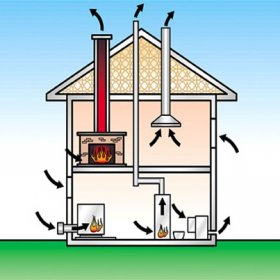
It would seem that it is difficult to install a chimney with your own hands in the task? The market is full of a wide variety of offers from domestic and foreign manufacturers. But professional stove-makers are well aware: in order to arrange a chimney that will serve for a long time and impeccably, you need to take into account a number of building rules and technical nuances. Only with their strict observance can the long and safe operation of the entire structure be ensured.
Content
Requirements for modern chimneys
Effective removal of smoke and gases generated during the combustion of fuel is a matter of safety and comfort. Good chimney:
- able to withstand heating to very high temperatures;
- resistant to moisture appearing in the process of condensation;
- resistant to aggressive chemistry (e.g. sulfuric acid);
- has excellent traction, etc.
The optimal shape of the chimney is cylindrical, while the walls should be as smooth as possible so that as much as possible soot accumulates on them, which will prevent frequent cleaning of the chimney.
Note! If you plan to install the chimney yourself, it makes sense to evaluate the problems associated with the transportation of the structure and the level of complexity of installation. Novice builders should definitely discuss the features of the device with an experienced specialist. Such advice can be obtained, for example, from suppliers of heating equipment.
A number of requirements for modern chimneys are regulated by building codes, for example:
- the cross-sectional area of the chimney must equal or exceed the area of the corresponding pipe of the heating boiler;
- for the manufacture of metal chimneys, high-quality alloy steel should be used, which is characterized by increased anti-corrosion properties and has a thickness of at least 0.5 mm
- special pockets of at least 250 mm deep should be arranged at the base of the smoke channels to enable the removal of soot deposits;
- the manufacture of a chimney having more than three turns is not allowed;
- the radius of curvature of the rotation of the chimney must not exceed the dimensions of the diameter of the chimney pipe;
- the total length of the chimney should be five meters or more
- etc.
Compliance with the above norms will allow you to create the necessary draft and sufficient rarefaction of gases in the chimney.
How to choose a suitable design?
The owner of a private house will have to choose from such common types of chimneys as:
- brick;
- steel;
- coaxial;
- ceramic.
The choice will depend not so much on the personal preferences of the owner of the house, but on the type of heating equipment. It is necessary to consider:
- flue gas temperature;
- the pressure of the combustion products in the chimney;
- the presence of condensate;
- amount of aggressive chemicals generated during fuel combustion;
- resistance of the chimney to soot fire;
- required distance from structures, etc.
Brick chimney is considered a budget option, but it can only be used with solid fuel boilers. A thick brick wall can withstand the high temperatures characteristic of this type of fuel. Even if soot burns in the pipe, the brick chimney will not be particularly affected.
But when using gas, liquid fuel, as well as for pyrolysis or pellet boilers, a brick chimney is not acceptable. The relatively low combustion temperature leads to the formation of condensate, which quickly destroys the brickwork.
Note! When replacing a solid fuel boiler with a gas boiler, a brick chimney can be adapted to the new system by simply inserting a special steel insert inside. In this case, the installation of a new chimney will require minimal costs.
For gas and liquid fuel boilers, as well as for pellet and pyrolysis systems, ceramic chimneys are recommended, which are durable, corrosion resistant and amazing durability. Keep in mind that installation of a ceramic chimney must be performed very carefully and thoroughly, in full accordance with the manufacturer's recommendations. Details of the installation of the ceramic chimney are described in the video material:
If you have to put the boiler in a room where there is no channel for the chimney, the best choice will be steel chimney. It is not as durable as ceramic, but it copes with the task of removing combustion products quite successfully. Its main advantages: low weight, relatively low price and easy to install.
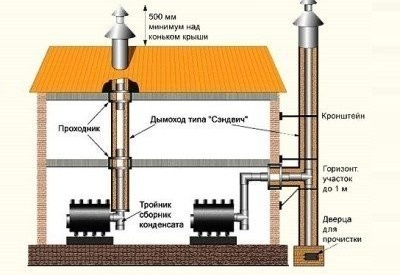
This diagram allows you to get a general idea of the features of the installation of a steel chimney, as well as options for its installation: indoors or outdoors
Brick and ceramic structures are characterized by a sufficiently high physical weight, which creates an additional load on the foundation. Often, for such structures it is necessary to create a separate foundation, which is not connected with the main one. Therefore, the correct installation of the chimney in a private house may require appropriate engineering calculations.
Note! If two boilers with different characteristics are used at the same time, then a chimney designed for higher loads should be chosen. For example, steel structures with thin walls are not suitable for solid fuel boilers, because due to the high temperature the steel will soon burn out.
Basic rules for installing any chimneys
When figuring out how to properly make a chimney in a house, several general rules should be taken into account:
- Mount the elements of the system from the bottom up.
- The inner pipe of the system should be inserted into the previous element, but the part of the outer circuit is put on the previous one. This will prevent condensation from entering the insulation located inside the circuit.
- For fastening chimneys with bends, tees, and similar elements, clamps are used.
- The joints should be outside the thickness of the floors.
- A tee usually requires a support bracket.
- For every two meters of the chimney, there must be one wall mount.
- When fixing the chimney to the wall, make sure that the pipe does not form a deflection.
- Contact of the smoke channel with any communications: gas pipe, electrical wiring, etc., is not allowed.
- When passing roofs and ceilings, indent 150 mm for pipes with insulation and 300 mm for pipes without insulation.
The creation of horizontal sections of the chimney longer than 1 m is not allowed.
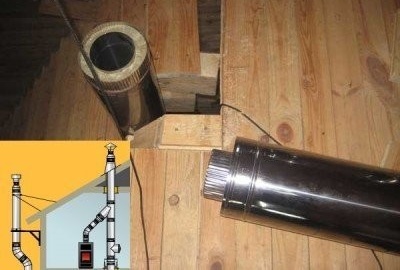
In accordance with the building regulations, when installing the chimney, the joints should not be in the thickness of the ceilings or roofing cake
Also, when installing a steel chimney, it is necessary to take into account the possibility of thermal deformation of the system. For this, a special flexible adapter is installed. If for some reason this element is missing, it is necessary to fix the pipe to the bracket not rigidly, but with a margin of 10-15 mm. Otherwise, the chimney may shift when heated.
If the roof of the building in which the chimney is installed is made of combustible materials, a special spark trap should be installed on the chimney. It is made of metal mesh, the openings of which do not exceed 5X5 mm.
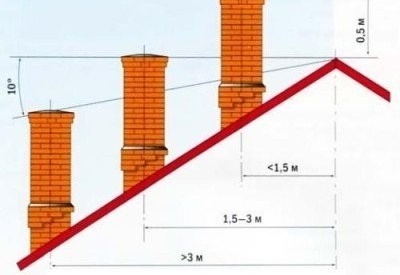
The height of the chimney depends on how close the pipe is to the ridge. If the distance to the ridge is less than 1.5 m, then the pipe should rise above the ridge by 500 mm
A few words about security
There are a number of requirements for the safe operation of chimneys. For example, it is not recommended to use flammable liquids or other similar flammable materials for kindling. In solid fuel boilers, firewood whose length exceeds the size of the furnace cannot be used.
In everyday life, one should refrain from the desire to use the chimney as a dryer for wet clothes, shoes, clothes, etc. Trying clean the chimneyBurning soot out of it can lead to premature failure. You should also not clean the chimney with chlorine-based products. Trying to fill the fire in the firebox with water can also be fatal for equipment.
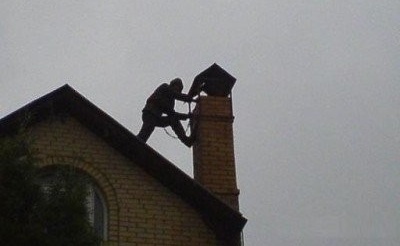
To ensure that the operation of the chimney is safe, it is necessary to clean the chimney and diagnose its condition at least twice a year
In order for the chimney to work properly, it is necessary to clean and maintain it at least twice a year. During operation of the boiler, one should strictly adhere to the recommendations set forth by the manufacturer and not try to use the heat-generating device in any other way.
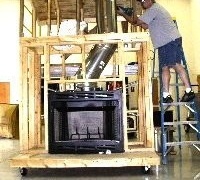
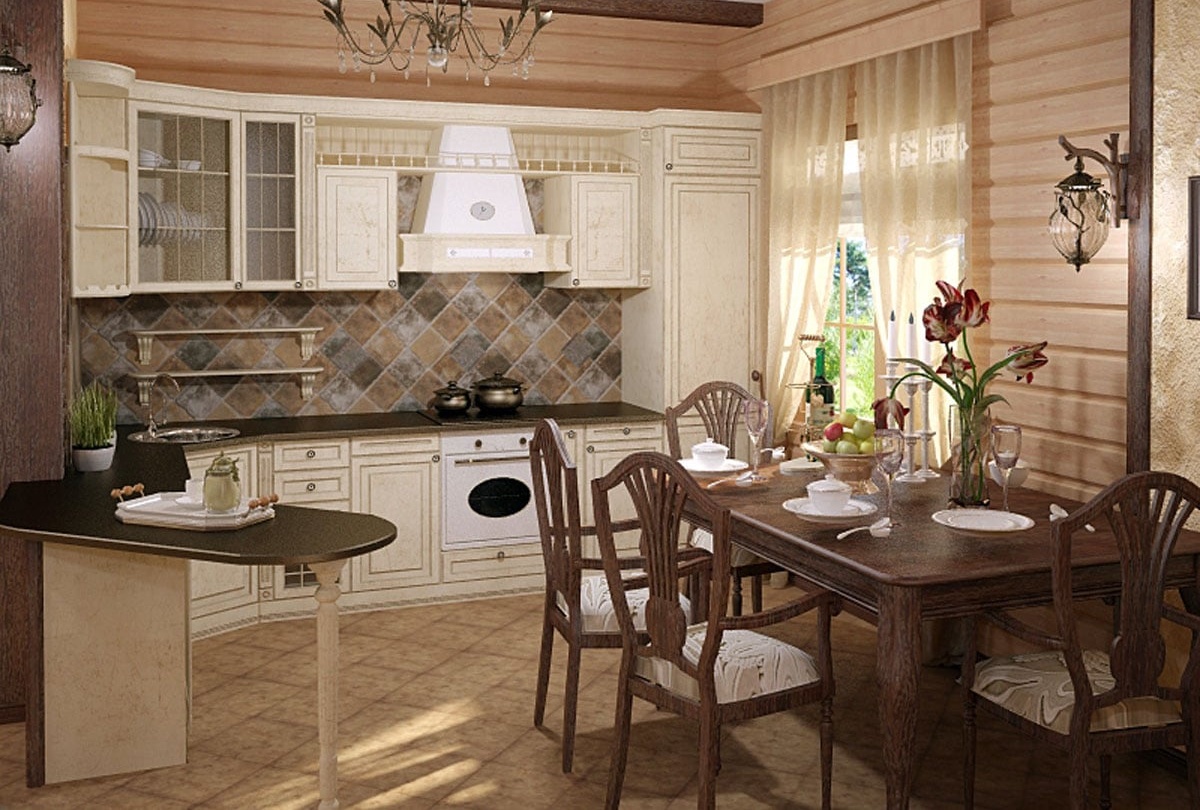
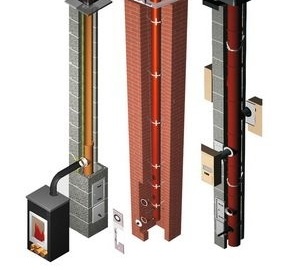
1 comment